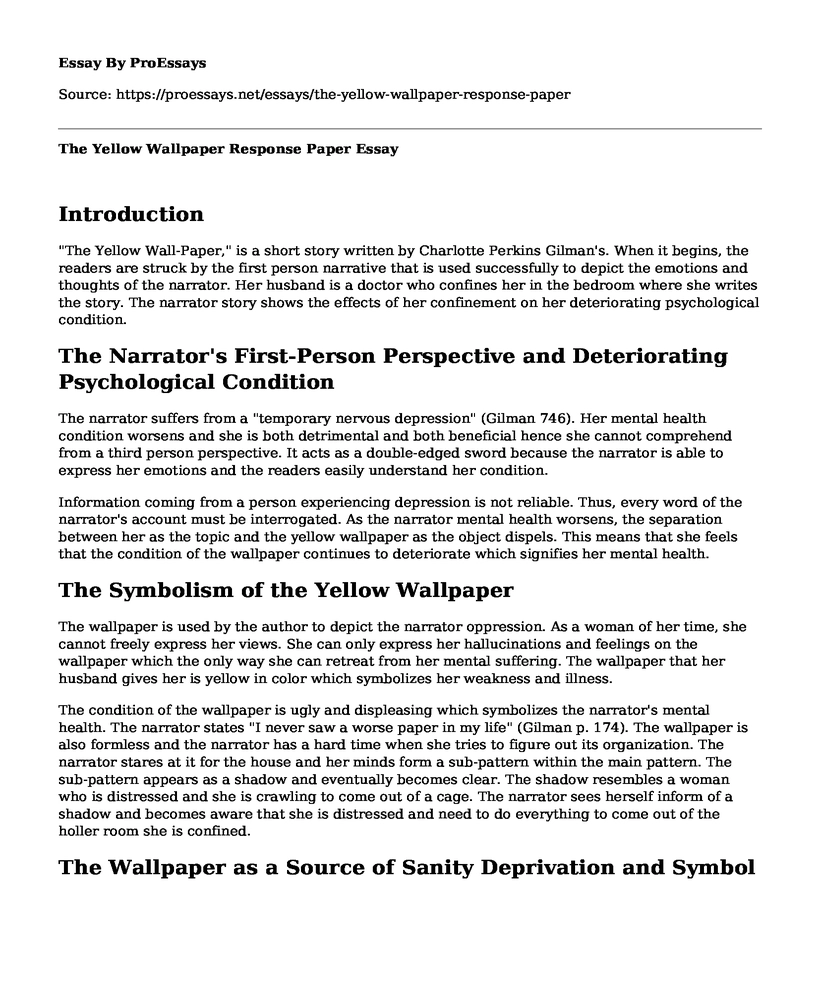Introduction
"The Yellow Wall-Paper," is a short story written by Charlotte Perkins Gilman's. When it begins, the readers are struck by the first person narrative that is used successfully to depict the emotions and thoughts of the narrator. Her husband is a doctor who confines her in the bedroom where she writes the story. The narrator story shows the effects of her confinement on her deteriorating psychological condition.
The Narrator's First-Person Perspective and Deteriorating Psychological Condition
The narrator suffers from a "temporary nervous depression" (Gilman 746). Her mental health condition worsens and she is both detrimental and both beneficial hence she cannot comprehend from a third person perspective. It acts as a double-edged sword because the narrator is able to express her emotions and the readers easily understand her condition.
Information coming from a person experiencing depression is not reliable. Thus, every word of the narrator's account must be interrogated. As the narrator mental health worsens, the separation between her as the topic and the yellow wallpaper as the object dispels. This means that she feels that the condition of the wallpaper continues to deteriorate which signifies her mental health.
The Symbolism of the Yellow Wallpaper
The wallpaper is used by the author to depict the narrator oppression. As a woman of her time, she cannot freely express her views. She can only express her hallucinations and feelings on the wallpaper which the only way she can retreat from her mental suffering. The wallpaper that her husband gives her is yellow in color which symbolizes her weakness and illness.
The condition of the wallpaper is ugly and displeasing which symbolizes the narrator's mental health. The narrator states "I never saw a worse paper in my life" (Gilman p. 174). The wallpaper is also formless and the narrator has a hard time when she tries to figure out its organization. The narrator stares at it for the house and her minds form a sub-pattern within the main pattern. The sub-pattern appears as a shadow and eventually becomes clear. The shadow resembles a woman who is distressed and she is crawling to come out of a cage. The narrator sees herself inform of a shadow and becomes aware that she is distressed and need to do everything to come out of the holler room she is confined.
The Wallpaper as a Source of Sanity Deprivation and Symbol of Oppression
As the story continuous, the wallpaper is the object that deprives the narrator of her sanity and freedom. The wallpaper is responsible for her husband mistreatment which includes confining her to a dark room and she is distressed. The wallpaper is a symbol of lack of mental exercise and physical help that causes the deterioration of the narrator's mind. The narrator is imprisoned in a nursery with the wallpaper which is a form of seclusion for female patients. Her husband has total control over her life and he makes her acknowledge the position in the society. Although she complains about the wallpaper medication, her husband state that it the best medication for her. The wallpaper represents the oppression of women by a male-dominated society.
Conclusion
In conclusion, in "The Yellow Wall-Paper," Charlotte Perkins Gilman's uses the metaphor of the wallpaper to depict the narrator mental health. The wallpaper is ugly and displeasing that indicates that her mental health continues to deteriorate. The wallpaper makes the narrator helpless in the society. The wallpaper traps the mind of the narrator hence she cannot think reasonably. The wallpaper pattern surrounds the narrator and makes her restless. The physician prescribes rest and quiet place that represses her body and mind. The male-dominated society does not give women an opportunity to decide what they want in life.
Cite this page
The Yellow Wallpaper Response Paper. (2022, Jul 15). Retrieved from https://proessays.net/essays/the-yellow-wallpaper-response-paper
If you are the original author of this essay and no longer wish to have it published on the ProEssays website, please click below to request its removal:
- How Northup and Rowlandson Experienced Captivity
- The Discord in the Imagery of Health and Death in Hamlet Essay
- Essay Sample on Greek Characterization
- A Summary on Oedipus the King
- Poetry Analysis Essay on Love Is a Two-Way Street: Exploring Its Metaphorical Meaning
- Essay Example on Romanticism: The Power of Human Emotions & Nature
- Essay Example on Ernest Hemingway's Sun Also Rises & A Farewell to Arms







